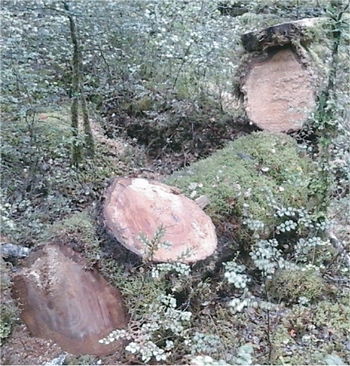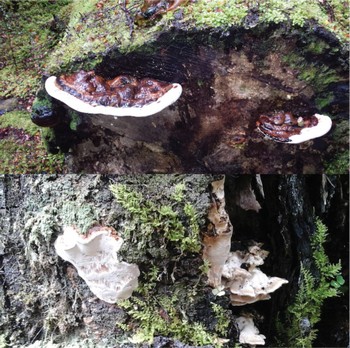PESTS AND DISEASES OF FORESTRY IN NEW ZEALAND
Decay fungi in fallen native trees
Scion is the leading provider of forest-related knowledge in New Zealand
Formerly known as the Forest Research Institute, Scion has been a leader in research relating to forest health for over 50 years. The Rotorua-based Crown Research Institute continues to provide science that will protect all forests from damage caused by insect pests, pathogens and weeds. The information presented below arises from these research activities.
From Forest Health News 285, October 2018.
In April 2014, Cyclone Ita caused extensive damage to native forests in the West Coast region of the South Island. The Department of Conservation (DOC), assisted by the Ministry for Primary Industries (MPI) authorised the commercial recovery of ca. 50% of fallen logs, requiring the remainder to be left as shelter and habitat for birds, insects and other indigenous biota. Among the latter are the many different fungi that colonise and decompose the uprooted trees and broken stems. These organisms are important because as they dismantle the wood molecules for their own use, they bring about the release of the bound chemical elements, recycling them as nutrients necessary for the life and growth of the trees and shrubs that make up the forest.
The effects of storms and salvage logging on the diversity of the tree decay fungal communities in our native forests is not well understood.
To learn more, a study was undertaken in several undamaged South Island beech forests. This initial step was intended to provide a benchmark which could be used to measure the changes resulting from natural and human disturbance.
The study was conducted at three locations, in red and silver beech forest in the Maruia Valley near Lewis Pass, in mountain beech forest near Arthur’s Pass and at two sites in the Eglinton Valley, one in mountain beech forest and the other in red and silver beech forest.

Altogether, 15 naturally fallen stems of red, silver and mountain beech trees were selected for sampling. “Chips” (ca. 1-2 mm cube) taken from discs cut from the stems were plated onto two culture media, a general one for any decay fungi present and the other selective for basidiomycetes, which make up the bulk of the wood decay fungi. Fungi growing into the culture media were isolated by sub-culturing and identified morphologically and through DNA sequencing.
The spatial distribution of the fungi within each stem was visualised by means of three-dimensional diagrams. The most commonly isolated species were Australoporus tasmanicus, Ganoderma applanatum sensu Wakefield, Inonotus nothofagi, Pleurotus purpureo-olivaceus and an unidentified hymenochaetaceous species, but there were numerous others, including species of Armillaria.
Comparisons were made with similar work undertaken in both beech and podocarp-hardwoo d forests in different parts of the country over the last three decades. Data from these studies were examined together to compare the communities of decay fungi in fallen native stems.
The nature of the fungal community at a given scale is characterised by its composition (the species present), its richness (the number of different species) and its diversity (their relative abundance). At the tree level, a community of low diversity is composed of a few dominant species occupying most of the stem, while one high in diversity is made up of smaller colonies of many species. It was found that communities of basidiomycete fungi tended to have greater species richness and diversity within fallen stems of red and silver beech than in those of matai and tawa in podocarp-hardwood forest.
Many basidiomycete species were shared in common among all tree species studied, but others were more restricted in their host distribution. When all 54 stems from the various studies were analysed together, fungal species composition grouped separately between the three beech host species on the one hand and rimu and tawa on the other. This pattern was mirrored at the national level by a similar host clustering based on records of collections of wood colonising fungi held in two mycological herbaria.
In the South Island beech study, certain wood decay species were each found on several stems only at one site. This observation is suggestive of localised spore dispersal and conforms to international work indicating that most of the spores released are carried for only a relatively short distance before reaching and colonising a new host stem. Because of this limited and uneven dispersal behaviour, it has been found that the diversity of the decay fungi studied at the landscape level may be reduced (a) in forest reserves of diminished size and (b) in stands where trees are removed during selective logging that would otherwise eventually fall and remain on the forest floor as woody debris.

In New Zealand, recovery logging after storms in native forests is unlikely to affect the broader scale population numbers of most wood decay species, which are generally widely distributed, but incidence may be significantly reduced for those that are less common, and the existence of rare species may be threatened. Further studies are now needed to compare fungal diversities in storm-damaged stands with those in undisturbed forests.
Ian Hood (Scion)
Hood, I.A.; McDougal, R.L.; Somchit, C.; Kimberley, M.O.; Lewis, A.S.R.; Hood, J.O.L. 2018. Fungi decaying the wood of fallen beech (Nothofagus) trees in the South Island of New Zealand. Canadian Journal of Forest Research. Doi:10.1139/cjfr-2018-0179.
This information is intended for general interest only. It is not intended to be a substitute for specific specialist advice on any matter and should not be relied on for that purpose. Scion will not be liable for any direct, indirect, incidental, special, consequential or exemplary damages, loss of profits, or any other intangible losses that result from using the information provided on this site.
(Scion is the trading name of the New Zealand Forest Research Institute Limited.)

 Farm Forestry New Zealand
Farm Forestry New Zealand

